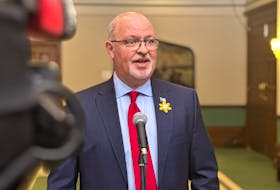ST. JOHN'S, N.L. — The question of whether Newfoundland and Labrador should have a $15 an hour minimum wage appears to be heating up, as the government reviews the current minimum wage formula.
Currently, Newfoundland and Labrador has the third-lowest minimum wage in the country, at $11.40, with a 25 cent increase last introduced in April. Once October hits, this province will have the second-lowest minimum wage, when Manitoba’s rate increases to $11.65. Only Saskatchewan will have a lower minimum wage by the end of the year, at $11.32 after its October increase.
Two years after introducing legislation to index the current minimum wage to the national inflation rate, the government is beginning its public consultations. Documents released through access to information legislation show at least four meetings with groups like Common Front NL in favour of a minimum wage increase, as well as meetings with the Newfoundland and Labrador Employers Council and the Canadian Federation of Independent Business (CFIB), which oppose an increase.
The St. John’s and Corner Brook area boards of trade also announced a campaign against a $15 per hour minimum wage earlier this year.
Tony Fang, an economics professor at Memorial University specializing in labour economics, says there’s a give and take when it comes to the minimum wage, which has to be considered by policy-makers.
“On one hand, if low-wage individuals can maintain employment before and after the change in minimum wages, then they would benefit from wage increases. That’s pretty clear,” said Fang.
“The tradeoff indicates that, unfortunately, some low-wages workers that a minimum wage intends to help may lose their job because of the reduced demand on the employer side because of a higher labour cost.”
In 2018, the unemployment rate declined by one percentage point, to 13.8 per cent, with it projected to decrease to 13.1 per cent in 2019.
Fang says there are other options policy-makers can consider if the intent of a minimum wage increase is to reduce income inequality.
“It can reduce poverty, there’s no doubt about that. It can increase the wages of low-wage workers. It can reduce income inequality,” he said.
“But it’s not efficient or effective policy to reduce income inequality.”
Fang says tax relief can be a more effective tool for supporting those with low incomes, without affecting the minimum wage and potentially affecting employment. He points to measures like the Canada Workers Benefit, formerly the Working Income Tax Benefit (WITB), which was changed in the 2018 federal budget. Under that program, a low-income worker making $15,000 a year would receive about $1,100 in tax relief, according to federal documents.
But Alyse Stuart, chair of lobby group Common Front NL, says the job losses forecasted by economists haven’t come through in Alberta, which increased its minimum wage to $15 an hour in October 2018. After steady increases to the minimum wage from 2016 to 2018, Common Front says, 8,600 jobs were added to Alberta’s food service sector, which is largely populated by minimum wage earners.
According to Common Front NL, one-third of workers in Newfoundland and Labrador make less than $15 an hour, making up approximately 70,000 people.
According to government documents released through access to information, of the 205,900 workers in the province in 2018, about 13,200 earned the existing minimum wage. Of those, 7,200 were youth between age 15 and 24, while 6,900 were women.
Stuart says the fears over major job losses as a result of an increased minimum wage did not come through.
“The other important myth to dispel is that it’s small businesses that are employing folks on minimum wage. It’s not. It’s these large, multi-national corporations that are – your Walmarts, your McDonalds,” said Stuart.
“They’re the largest minimum wage suppliers, if you will, to this province. We’ve had pushback saying Walmart will leave. Walmart hasn’t left Seattle, Ontario or Alberta. Walmart is doing just fine in those areas (with a higher minimum wage).”
But the CFIB disagrees. Among the documents released through access to information is a letter from the CFIB to Advanced Education, Skills and Labour Minister Bernard Davis regarding the minimum wage.
The CFIB put out a call in 2018 for small businesses for their perspective on a $15 an hour minimum wage and received 135 signatures from small business owners across the province voicing their opposition.
Brenda Tobin, owner of Tobin’s Convenience in St. John’s, wrote, “This is madness and could mean us closing up,” on her submission, which was sent to the government in January.
Politics of minimum wage
As consultations ramp up, the reality of a minority government could make the debate particularly interesting.
The Liberals have increased the minimum wage to where it stands today, and introduced indexing the minimum wage to inflation, a move applauded at the time.
Davis says he’s not going to prejudge the outcome of the consultations on whether or not any increases to the minimum wage will come, outside of the regular increases tied to inflation.
“Organizations on both sides of the equation have met with me on this issue to make sure I’m aware of their concerns and what they’re advocating for,” he said.
Davis says the fact that there’s a minority government in place doesn’t change his approach to the consultations.
New Democratic Party Leader Alison Coffin says her party has pushed for a $15 an hour minimum wage for years, with it appearing as a key part of the party's most recent election platform.
Coffin says while employment figures could move up or down, the benefits to an increased minimum wage could appear in ways not predicted by the math.
“Does this mean that mom has to do childcare because one person is hired, but that person won’t get enough money to be able to pay for childcare. You’re pulling resources in a community that could be better used elsewhere,” she said.
“You get some of these social costs that we don’t often measure when we talk about dollars actually expended.”
The Progressive Conservatives declined comment for this story, citing an upcoming meeting with Common Front to further explore the issue.









